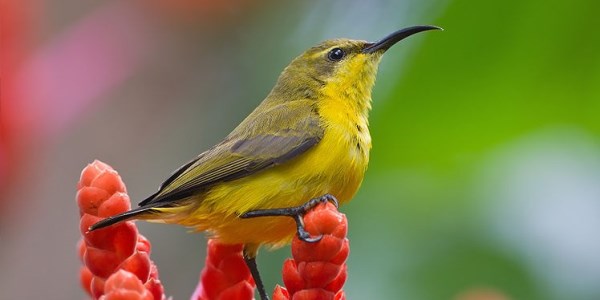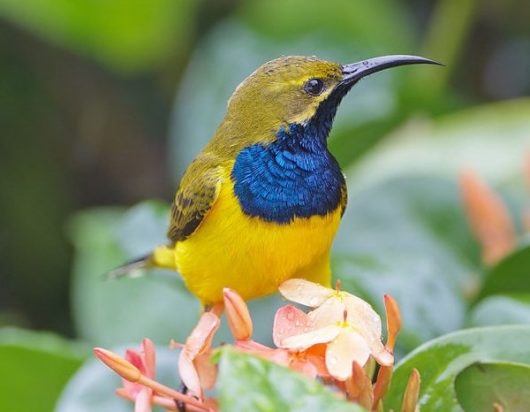LINKED PAPER
Increased sexual dimorphism in dense populations of Olive-backed Sunbirds on small islands: morphological niche contraction in females but not males. O’Connell, D.P., Kelly, D.J., Kelly, S.B.A., Sealy, S., Karya, A., Analuddin, K. and Marples, N.M. 2019. Emu – Austral Ornithology. DOI: 10.1080/01584197.2019.1588743. VIEW
Going right back to the time of Darwin, competition has always been seen as a driver of evolution. When we think of natural selection we often think of hyaenas and lions fighting it out on the plains of Africa, or a pack of wolves hassling a bear over a carcass. Resource competition like this is a daily part of survival for most animals, with a delicate balance of power between competitors which can change in different environments. However competition for resources takes place not only between species (interspecific competition), but within them (intraspecific competition), and often this is where competition is at its most fierce. Sexually dimorphic species present a special case when studying competition in different environments. They are species where the males and females are physically different, often in body size, but also in colouration and other characteristics. Males and females in sexually dimorphic species often occupy different but interlinked ecological niches. If intraspecific competition becomes more intense within a population of a sexually dimorphic species then one sex may suffer more than the other due to being smaller.
In our recent paper in Emu – Austral Ornithology we report on one such case with a niche contraction in female Olive-backed Sunbirds (Cinnyris jugularis), but not males, in a highly competitive environment on small islands. This work was carried out on the remote and understudied islands of South-east Sulawesi, Indonesia (Figure 1), where a joint team of scientists from Trinity College Dublin (TCD) and Halu Oleo University (UHO) have been carrying out research into bird evolution since 1999.
Figure 1 The Islands of South-east Sulawesi. This study took place on the mainland system islands mainland Sulawesi, Buton and Kabaena, and on the Wakatobi Islands Wangi-wangi, Oroho, Hoga, Kaledupa, Tomia, Lintea Selatan and Binongko. Sampling locations marked by a pin
South-east Sulawesi provides a perfect place to study evolution and competition, and how this is affected by different environments. The mainland of Sulawesi and its large continental islands (Buton, Muna and Kabaena) are ecologically complex and highly diverse. The small oceanic Wakatobi Islands, which have never been connected to the mainland, are much more barren and less species rich. Olive-backed Sunbirds are found throughout South-east Sulawesi. However most of their competitor species (principally the Brown-throated Sunbird (Anthreptes malacensis), Black Sunbird (Leptocoma aspasia) and Crimson Sunbird (Aethopyga siparaja)) are not found on the Wakatobi Islands, unable to survive on these small isolated islands. While surviving on small islands is clearly difficult for any species, the species that manage to succeed can massively benefit due to less interspecific competitors. Classic island biogeography theory would predict that populations of species which succeed in colonising the islands would be able to access more resources, increasing in number and occupying a wider ecological niche (MacArthur et al., 1972). For a sexually dimorphic species this wider ecological niche would likely result from both sexes expanding their niche in opposite directions, becoming even more sexually dimorphic, and so avoiding competition for resources between the sexes (intersexual competition) as well as accessing resources that would usually be taken by competing species in mainland areas (Selander, 1966; Butler et al., 2007). Therefore we predicted our Olive-backed Sunbirds on the Wakatobi Islands to be; 1) more sexually dimorphic, 2) that this greater dimorphism would be the result of both sexes widening their niche space and 3) that these changes would be associated with much denser populations of Olive-backed Sunbirds.
Figure 2 Male Olive-backed Sunbird (Cinnyris jugularis) | JJ Harrison | CC BY 3.0
To test whether our predictions were correct the TCD/UHO team collected data on Olive-backed Sunbirds throughout the islands of South-east Sulawesi, both on the mainland and large islands and on the small isolated Wakatobi Islands (Figure 1). Birds were trapped using mist nets to take multiple measurements of their body and bill size as an indicator of their ecological niche, before releasing the birds again. These morphological measurements were plotted as a multi-dimensional hypervolume to assess the morphological niche volume of male and female Olive-backed Sunbirds in each population. By calculating the overlap in morphological niche volume between females and males in each population we could analyse the level of sexual dimorphism. Less overlap of their morphological niche meant the males and females were less morphologically similar, and so more sexually dimorphic. In addition line transect surveys were completed to estimate the Olive-backed Sunbird population density, counting all individuals encountered on each 1km transect.
Our results were partially as predicted, and partially surprising. The Olive-backed Sunbirds on the Wakatobi Islands did show greater sexual dimorphism and higher population density than on mainland Sulawesi (confirming prediction 1 and 3). However this was not associated with an increase in niche volume by either female or male sunbirds, the males remained unchanged in niche volume while the female’s niche was smaller. This disproved prediction 2 and runs counter to established theory suggesting that populations experiencing less competition will expand in niche. Therefore we found no evidence of a direct effect of reduced interspecific competition on Olive-backed Sunbird niche. Rather than being able to expand their niche, in the high density populations of the Wakatobi Islands, females have become more specialised, taking up a smaller subset of their niche space, overlapping less with that of the males. Olive-backed Sunbirds have loose territory boundaries, and many pairs often compete for high value resources, so in the high-density populations of the Wakatobi Islands it may pay for females to avoid competition with males. Our study shows that competition can indeed be a powerful force in evolution, but that the effects of interspecific can be over-emphasised, and more attention should be paid to intraspecific competition, particularly for sexually dimorphic species.
Acknowledgements
Thanks to TCD, Halu Oleo University and Operation Wallacea for facilitating, planning and providing logistical support for this research. A big thanks to Kementerian Riset Teknologi Dan Pendidikan Tinggi (RISTEKDIKTI) for providing the necessary permits and approvals for this study (0143/SlP/FRP/SM/Vll/2010, 278/SlP/FRP/SM/Vll/2012, 279/SIP/FRP/SM/VIII/2012, 174/SIP/FRP/E5/Dit.KI/V/2016, 159/SIP/FRP/E5/Fit.KIVII/2017 and 160/SIP/FRP/E5/Fit.KIVII/2017). Finally, we like to thank all of the research assistants who contributed across many field seasons.
Nominate this article for a BOU Science Communication Award.
References
Butler, M.A., Sawyer, S.A., & Losos, J.B. 2007. Sexual dimorphism and adaptive radiation in Anolis lizards. Nature 447: 202–205. VIEW
MacArthur, R.H., Diamond, J.M., and Karr, J.R. 1972. Density compensation in island faunas. Ecology 53: 330-342. VIEW
Selander, R.K. 1966. Sexual dimorphism and differential niche utilization in birds. The Condor 68: 113-151. VIEW
Image credits
Featured image: Female Olive-backed Sunbird (Cinnyris jugularis) | JJ Harrison | CC BY 3.0






